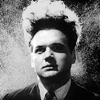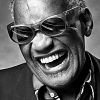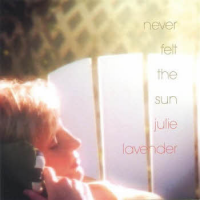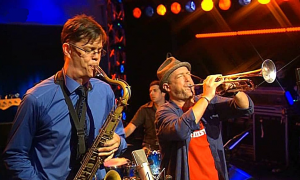Home » Jazz Articles » Genius Guide to Jazz » What I Say
What I Say
Young Ray won the right to pursue the piano in the landmark Supreme Court decision Robinson v. Some Dumbass Crackers (1939)
 If they ever make a biopic out of my life, and there's no clear reason why they wouldn't since I am the Dean of American Jazz Humorists® and one of the world's foremost experts on baseball's balk rule, I hope they are able to get Jamie Foxx to reprise his Oscarâ"¢-winning role in the pivotal "Genius writes his Ray Charles piece scene. But if it comes down to it, I'd rather they spend the budget money on the absolutely necessary "Thora Birch recreates Phoebe Cates' swimming pool scene from Fast Times at Ridgemont High sequence.
If they ever make a biopic out of my life, and there's no clear reason why they wouldn't since I am the Dean of American Jazz Humorists® and one of the world's foremost experts on baseball's balk rule, I hope they are able to get Jamie Foxx to reprise his Oscarâ"¢-winning role in the pivotal "Genius writes his Ray Charles piece scene. But if it comes down to it, I'd rather they spend the budget money on the absolutely necessary "Thora Birch recreates Phoebe Cates' swimming pool scene from Fast Times at Ridgemont High sequence.So then.
Ray Charles Robinson was born in Albany, Georgia, on September 23, 1930. Very shortly thereafter, his parents moved over the border to Greenville, Florida, due to Depression-era rationing of future musical legends. Florida received Ray and the future rights to Tom Petty, while Georgia received Gregg and Duane Allman, Otis Redding, and a bassist to be named later.
 Perhaps the most defining moment in young Ray's life came when he lost his sight at around the age of seven. Even then, Ray displayed the tenacity and independence that would be characteristic of his entire life and career; bucking restrictive post-Reconstruction Southern laws requiring all blind black men to become blues guitarists. Astute even then, young Ray invoked the "Blind Tom Bethune exemption which was on the books in Virginia and won the right to pursue the piano in the landmark Supreme Court decision Robinson v. Some Dumbass Crackers (1939).
Perhaps the most defining moment in young Ray's life came when he lost his sight at around the age of seven. Even then, Ray displayed the tenacity and independence that would be characteristic of his entire life and career; bucking restrictive post-Reconstruction Southern laws requiring all blind black men to become blues guitarists. Astute even then, young Ray invoked the "Blind Tom Bethune exemption which was on the books in Virginia and won the right to pursue the piano in the landmark Supreme Court decision Robinson v. Some Dumbass Crackers (1939).Ray went on to the St. Augustine School for the Deaf and Blind, where he took full advantage of their excellent Future Celebrity program. He particularly excelled in their pioneering Product Spokesman curriculum, as well as their Late Night Talk Show Guest course, and was a 4-year letterman on the Advertising Jingle team. But by the age of 15, Ray felt he had learned all that St. Augustine could teach him and left the school to pursue his career as a professional musician.
Hanging around Florida's music scene just long enough to realize that there wasn't one, Ray moved to Seattle. Though he didn't stay long, relatively speaking, his impact on the Emerald City has reverberated for decades. By demonstrating that it was possible to go on to worldwide stardom from the unlikely Pacific northwest, Ray was a model for those to come, from Jimi Hendrix in the sixties to Heart in the seventies to everyone with a flannel shirt and a mood disorder in the nineties. And so kinetic and energetic was Ray's music that since his departure in the 50's, the town has required gallons of coffee a day per resident just to replace the stimulus.
 From Seattle, Ray formed the McSon Trio (later, a popular breakfast entrée at McDonald's) and shortened his name to Ray Charles after boxer "Sugar Ray Robinson won the rights to the name Robinson on October 15, 1952, at the Olympic Auditorium in Los Angeles. Sugar Ray won a majority decision (Art Tatum scored the fight 144-141, Charles), and the newly titled Ray Charles avenged his defeat by going out on the road with blues guitarist Lowell Fulsom. The pair would later beat Gorgeous George and Killer Kowalski in a two-man tag team bout, and during the match Ray would invent a powerful piledriver move he called the "Hit the Road Jack. And now you know the rest of the story.
From Seattle, Ray formed the McSon Trio (later, a popular breakfast entrée at McDonald's) and shortened his name to Ray Charles after boxer "Sugar Ray Robinson won the rights to the name Robinson on October 15, 1952, at the Olympic Auditorium in Los Angeles. Sugar Ray won a majority decision (Art Tatum scored the fight 144-141, Charles), and the newly titled Ray Charles avenged his defeat by going out on the road with blues guitarist Lowell Fulsom. The pair would later beat Gorgeous George and Killer Kowalski in a two-man tag team bout, and during the match Ray would invent a powerful piledriver move he called the "Hit the Road Jack. And now you know the rest of the story.The next most epochal event in Ray's life was when he met Ahmet Ertegun, founder of Atlantic Records. To this point, Ray had primarily made his living by emulating other singers, particularly Nat "King Cole. Ertegun recognized the possibilities presented by Ray's talents, and encouraged him to explore his own ideas. Charles responded by inventing a brilliant amalgam of R&B and gospel that would be known as soul music (U.S. patent 6,212,464).
During Ray's tenure with Atlantic he became a bona fide superstar, charting single after single and redefining the way the country listened to "race music. Previously, 1950's America felt uncomfortable listening to black people sing right out in front of God and everybody.
 Ray's rich, expressive voice and unique piano style, along with his personal charisma, made it safe for Caucasians to listen to songs like "I Got A Woman without having to wear elaborate disguises and speak with thick Dutch accents to avoid detection.
Ray's rich, expressive voice and unique piano style, along with his personal charisma, made it safe for Caucasians to listen to songs like "I Got A Woman without having to wear elaborate disguises and speak with thick Dutch accents to avoid detection.Ray used his celebrity to make a stand for the civil rights movement, refusing to play a show in Georgia because the audience would have been segregated. The state of Georgia responded by banning Ray from performing in the state, a move they later rescinded in more enlightened times. Georgia would come to embrace their native son, making Ray's "Georgia on My Mind their state song and passing a constitutional amendment banning slackwitted hacks from using the term "blind ambition when writing about Charles.
Ray ushered in the sixties by moving from intimate Atlantic to behemoth ABC Records. Leaving the comfortable, almost family-like atmosphere at Atlantic was difficult, but Ray felt that the larger label would allow him the resources to transcend mere superstardom and become a cultural icon. He knew he was on the right track the minute those Franklin Mint collectible plate bastards started sniffing around his door.
The move to ABC also showed more of Ray's considerable business acumen as well. When Ray signed with ABC, he asked for and got the rights to his own master recordings. This was an unprecedented deal in the recording industry, who routinely compensated artists with nothing more than brightly-colored beads and pebbles.
 The exponential increase in Ray's fame exacerbated his decades-long addiction to heroin. Several arrests for possession garnered unwanted attention, though they did little to affect his public persona. Perhaps the most conspicuous effect of his drug use was his 1962 album, Modern Sounds in Country and Western Music. Only a well-timed intervention and subsequent stay in a treatment facility saved Ray from the eventual indignity of a rhinestone-studded suit and a belt buckle the size of a dinner plate. It could not save him, however, from an appearance on Hee Haw.
The exponential increase in Ray's fame exacerbated his decades-long addiction to heroin. Several arrests for possession garnered unwanted attention, though they did little to affect his public persona. Perhaps the most conspicuous effect of his drug use was his 1962 album, Modern Sounds in Country and Western Music. Only a well-timed intervention and subsequent stay in a treatment facility saved Ray from the eventual indignity of a rhinestone-studded suit and a belt buckle the size of a dinner plate. It could not save him, however, from an appearance on Hee Haw.Moving along.
With most of the heavy lifting of becoming a worldwide superstar behind him, Ray was finally able to sit back and enjoy the fruits of his labor. Such as papaya. Man, did Ray love him some papaya. Which doesn't have a damned thing to do with anything, but I needed something to cleanse the palate after that unpleasant heroin and country music business in the last paragraph.
Never content to rest on his laurels, Ray continued to expand his horizons. His recording output ran the gamut from soul, his own creation, to timeless American standards. He appeared in movies, most notably in the classic 1980 comedy The Blues Brothers, and engaged in playful self-parody as a frequent late night TV show guest. Unfortunately, during the last two decades of his life, he became more known to Generations X and Y (and the sub-generation Sometimes Y) as an amiable, grandfatherly soda pitchman.
 Enter Taylor Hackford, a well-known Hollywood director who had already brought Chuck Berry to the big screen with the biopic/concert film Hail, Hail! Rock and Roll. Securing the rights to the story of Ray's life in 1987, Hackford began a long journey to making a movie about Ray's extraordinary life. Unable to find funding from any major studio, Hackford conducted exhaustive bake sales and car washes to raise the money to make the film independently. In 2004, Hackford completed the film and managed to get a distribution deal from Universal Studios in return for the recipe for his delightful blackberry popovers (see also Marsalis, Wynton).
Enter Taylor Hackford, a well-known Hollywood director who had already brought Chuck Berry to the big screen with the biopic/concert film Hail, Hail! Rock and Roll. Securing the rights to the story of Ray's life in 1987, Hackford began a long journey to making a movie about Ray's extraordinary life. Unable to find funding from any major studio, Hackford conducted exhaustive bake sales and car washes to raise the money to make the film independently. In 2004, Hackford completed the film and managed to get a distribution deal from Universal Studios in return for the recipe for his delightful blackberry popovers (see also Marsalis, Wynton).Exploding onto the screen with a tour de force performance by Jamie Foxx, the film presented a warts-and-all appraisal of Ray Charles' life. Far from damaging Ray's legacy, with its unflinching portrayal of drug use and marital infidelity, the film served to renew interest in Ray's most treasured contributions to American culture and society. By the time of his death from liver failure in June of 2004, he had finally received proper due for the full measure of his genius.
Till next month, kids, exit to your right and enjoy the rest of AAJ.
Tags
PREVIOUS / NEXT
Support All About Jazz
 All About Jazz has been a pillar of jazz since 1995, championing it as an art form and, more importantly, supporting the musicians who make it. Our enduring commitment has made "AAJ" one of the most culturally important websites of its kind, read by hundreds of thousands of fans, musicians and industry figures every month.
All About Jazz has been a pillar of jazz since 1995, championing it as an art form and, more importantly, supporting the musicians who make it. Our enduring commitment has made "AAJ" one of the most culturally important websites of its kind, read by hundreds of thousands of fans, musicians and industry figures every month.




















